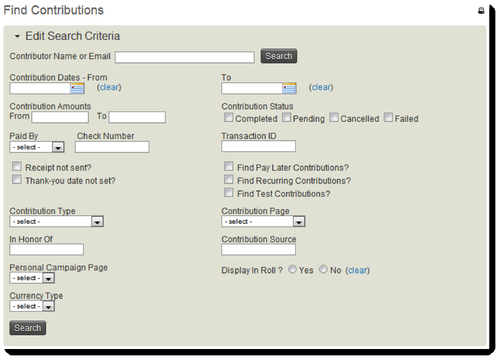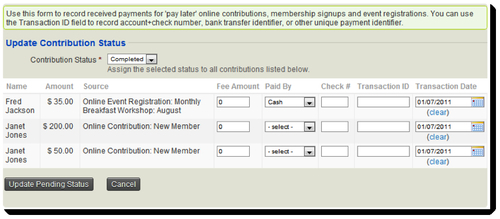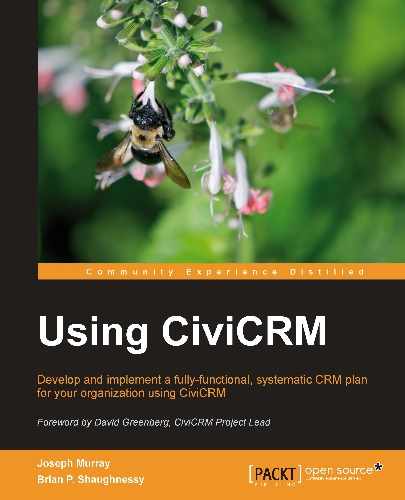So far we have focused our energy on understanding the key configuration options related to fundraising and working with single contact and pledge records within the contact record. In this section, we will work with contribution records in bulk and review "recipes" for implementing fundraising techniques through CiviCRM. While working through this section, we will also highlight noteworthy features or places where you may see unexpected results if they are not handled correctly.
While you will often be working with contributions directly through the contact record, it is likely that much of your time will also be spent searching for and reporting on contribution records in bulk. For example, you will periodically need to know how many contributions were received over a period of time, such as the last month or year to date. You may need to export all contributions of the type "Donations" in order to send end-of-the-year statements for tax purposes. Alternatively, you may want to isolate donors who have given amounts over a certain threshold and classify them as Major Donors, targeting them in unique ways through postal mailings and e-mails.
As with other functionality areas in CiviCRM, you can conduct these searches using the component search at Contributions | Find Contributions or through the Contributions panel in Advanced Search. The field options are the same, but the results are quite different. Component searches will always return component records, whereas Advanced Search returns contact records by default. This means that if John Doe has three contributions matching my criteria, I will see three records in the CiviContribute component search (as distinct contribution records are returned) and only one in Advanced Search (representing the contact record). Further, actions, such as export and bulk update using profiles will reflect the source. In the Find Contributions tool, for example, you will be able to export contribution details.
Tip
In CiviCRM v3.3, the Advanced Search tool is extended to allow you to retrieve related records through this interface. Using the Display Results As drop-down, you can choose to retrieve contacts (default), activities, contributions, or event registration records. The benefit over using component searches is the ability to add criteria across multiple types of data, but retrieve the contact's related records in a different area. For example, I could retrieve all contributions for individuals with an Employee of relationship who have been members since 2004.
The following screenshot demonstrates the options available in the Find Contributions tool:

For the most part, these options are fairly intuitive and self-explanatory. We will review them briefly:
- Contributor Name or Email: It can be just a partial match.
- Contribution Dates - From and To: This will search the date on which the contribution was received (usually the date recorded).
- Contribution Amounts From and To: Criteria treated as equal to or greater than in the From field, and less than or equal to in the To Field.
- Contribution Status: Choose one or more of Completed, Pending, Cancelled, and Failed.
- Paid By, Check Number or Transaction ID: If you specify a value for Check Number, make sure that the Paid By field is either left empty, or has Check selected; otherwise no results will be returned.
- Receipt Not Sent?: This is convenient when generating a list of contributors to receive receipts.
- Thank-you date not set?: If checked, contributions with Thank-you date set are not returned, providing results that need to be sent "thank-you's". If unchecked, results are returned regardless of the value in Thank-you date.
- Find Pay Later Contributions?: If checked, only "pay later" contributions are returned. If unchecked, results are returned regardless of the value in Pay Later?.
- Find Recurring Contributions?: If checked, only recurring contributions are returned. If unchecked, results are returned regardless of whether the contribution is a recurring one or not.
- Find Test Contributions?: If checked, any contributions generated through the contribution page test form will be returned. By default, all test records will be excluded from the search results. Selecting this option is the only way to locate those records.
- Contribution Type: Provides a convenient way to search for payments for events, memberships, donations, or other contributions types that have been configured.
- Contribution Page: Provides a convenient way to search for memberships in a particular organization (or subscription), or donations to appeals that used specialized contribution pages (campaigns).
- In Honor Of: Provides a way to search for honorees by name.
Tip
Unlike most free text searches for contacts in CiviCRM, the In Honor of search field does not find contacts based on their part or complete name, or e-mail address by default. To get around this constraint, you can explicitly include wildcards (%) in what you are searching for. Wherever you put one, it will match any text. For example, %John% will match John Doe as well as well as Jane Johnson.
- Contribution Source: Must be an exact match unless using wildcards.
- Personal Campaign Page. Can be used to determine how well a campaigner is doing.
- Display In Roll?: If Yes is selected, only contributions to personal campaign pages which had "Show my contribution" in the public honor roll checked are returned. If No is selected, only contributions to personal campaign pages which had Show my contribution in the public honor roll unchecked are returned. If neither Yes nor No is selected, then contributions are returned regardless of this setting, whether they were made through a personal campaign page or not.
- Currency Type: If your CiviCRM implementation has more than one available currency (see Administer | Configure | Global Settings | Localization, Available Currencies), then users can select the currency in which they would like to contribute. Specifying a currency type here returns only contributions in that currency.
- Custom data fields for Contributions: You can filter search results on custom data fields.
After conducting a search for contributions, you are given a list of results with key details. From this list, you can directly access the contact or contribution record.
Each column in the search results—name, amount, type, source, received, thank-you sent, status, and premium—can be sorted in ascending or descending order. You also have the familiar View/Edit/Delete action links on the right of each row.
Clicking on the contact name in any contribution row takes us to their summary record. We can see the number of contributions and pledges as well as other tabbed items. By clicking on the Contributions tab, we get a good capsule summary of their donation history that encompasses recency, frequency, and monetary amount in three lines. The first shows Total Amount, # Contributions, and Average Amount for Current Year-to-Date. The total for all the years is in the second one. Specific donations follow in reverse chronological order. Note that these totals only take into consideration completed contributions (pending, canceled, and so on are excluded). Once again, the columns can be sorted, facilitating quick access to donations in multiple ways.
Before rushing off, it's also worth pointing out that fundraisers can record the receipt of an offline payment or view, edit, or delete a contribution for this contact using links right on the page.
After conducting a search for contributions, you can select some or all of the records and take action on them in bulk. The options available are different from what we saw in the contact search action list, as they are tailored to the needs of contribution records.
In this section, we will review those bulk actions, consider typical use cases for them, and walk-through how to make better use of the functionality available.
First conduct a search, select some or all records, and select the actions drop-down to review your options. After selecting an action to take on the selected records, click on Go to initiate it. The following subsections explain the various actions.
This tool is one way to update contributions from online "pay-later" contributions, or offline direct mail/telemarketing campaigns that have been received and entered manually by the administrative staff.
"Pay-later" contributions are left in a Pending status until the contribution is received (such as a check mailed in after the form was submitted). At a certain point, they may also be deemed to be failed donations if there is no longer any hope of collecting payment. The Update Pending Contribution Status action presents a batch update form optimized for dealing with this situation. It allows the Fee Amount, Paid By, Check #, Transaction ID and Transaction Date to be updated in a much quicker fashion than finding and editing these fields each individually. Once you have entered data for those fields and selected a new Contribution Status for the displayed records, click on Update Pending Status to save all the changes.
Note that all contributions selected by your search must have a status of pending in order to use this tool; else, an error message is displayed.

One excellent use of this action is to follow-up on records that have just had their contribution status updated from Pending to Completed. After clicking Done following any action you are returned to the search results and can proceed with additional actions. Select Print or E-mail Contribution Receipts from the list and click on Go.
PDF receipts creates a PDF file of receipts that can be printed and mailed, while E-mail Receipts sends receipts to donors of all selected records via e-mail. After clicking to Process Receipt(s) you will be returned to the search results (if you e-mailed receipts) or be prompted to save the PDF file (if you are generating PDF receipts). Note that receipts are generated using the Contribution - Receipt (on-line) template (see Administration | Configure | Message Templates, System Workflow Messages for more details).
Working the same as the corresponding contact search action, this tool allows you to generate and send an e-mail activity to search results. One possible use of this action is to send thank-you e-mails to donors who will be receiving signed hard-copies of receipts where jurisdictions do not accept e-mail receipts for tax purposes.
Complete the standard Send E-mail activity form, selecting the From e-mail, CC, and BCC as appropriate; entering a Subject line; and providing the content of the e-mail. As with other uses of this tool you can choose to Use Template, and supply either/both HTML Format and Plain-Text Format content as desired. The e-mail content may be saved as a new template or if an existing template was used, it may be updated. If you've enabled attachments in your Global Settings, you may add them here.
Also based on the contact search equivalent tool, this option allows you to update up to 100 records at once in a grid-style layout using a predefined profile to define the columns/fields that will be edited. For the purposes of illustrating the usefulness of this action, we will create a profile with contribution fields, and then use it to alter the status and several other contribution fields. Like batch update actions carried out on other records, you will be able to edit the fields exposed in the contribution profile in a much quicker fashion than finding and editing each contribution record individually.
Create a profile at Administer | Custom | CiviCRM Profile and select a few contribution-type fields, such as the thank-you date, payment instrument, and check number. It's not necessary to add contact-related fields as profiles with only contribution fields display the name, e-mail, and address of the donor automatically. After saving the profile, return to your search results or reinitiate them, select one or more contributions, and choose the Batch Update Contributions Via Profile action. You will be presented with a list of profiles that can be used for this purpose. Select the profile you just created and click Continue.
You will be presented with a grid/spreadsheet type layout where you can edit fields for multiple records and save them in a single step. Note the icon next to the title of each column. Clicking on the icon will copy the value present in the first row to all subsequent rows. This is a great way to mass update records with the same value. For example, if you send out a batch of thank-you letters to all donors who contributed over the last month, you can conduct your search and use this tool to update the Thank-You field for all records at once.
Some organizations track each donation in their accounting software (for example, Simply Accounting, AccPac, and Quickbooks), while others use CiviCRM to track this information and only transfer summary information to their accounting system (for example, total revenue for each donation type for each month). As CiviCRM's bookkeeping feature set grows stronger, more organizations will be able to shift to relying completely on CiviCRM for individual transaction tracking. Those still tracking all donors and donations in their accounting package will continue to need to export contributions from CiviCRM so they can be imported into the accounting system. This is a prime example of when the Export Contributions action is useful.
If you are an organization that does its books on a monthly basis, you might wait until the fifth or tenth of the month to migrate data from CiviCRM to your accounting package. At that point every month you would click on Contributions | Find Contributions, use criteria such as All contributions with a contribution status of Completed and a received date of the previous calendar month, and click on Search.
Next, select all of these contributions and choose Export Contributions from the action drop-down. At this point, you may export a pre-defined set of default fields (Export PRIMARY fields) or choose to select which fields you would like to export. When choosing which fields to export, you may save the field mapping and name it for easy retrieval on future exports.
Since the export process separates the records to be exported from the data columns actually included in the file, the field mapping can be reused for different export purposes. Depending on your work processes in CiviCRM, you may find it useful to construct a single export mapping that covers multiple export-related needs. Simplifying procedures so that only one data migration format is used is likely to reduce development and operating errors.
As the action title suggests, this is used for bulk deletion of contributions.
However, we strongly discourage deleting financial data transactions and will suggest some ways to prevent any users from having permission to delete financial transactions. A better practice is to post reversing transactions or use the status to communicate why the original transaction has changed (for example, by marking as cancelled and providing an explanation for the action).
One exception may be when you clean out test records from your system. In general, test records are well-hidden from the interface. You must explicitly choose to include them from the Find Contributions tool (check Find Test Contributions?); otherwise, they will be excluded by default.
However, it is reasonable to want to periodically search for these test records and use the bulk Delete Contributions action to remove them from the system. Be sure you have a recent backup of your database before performing any bulk deletion of this sort.
As you can see, CiviCRM provides a number of powerful tools for working with contribution records in bulk. Take time to explore the features available so that you know your options when you are working with records and have a clear understanding of what they do.
